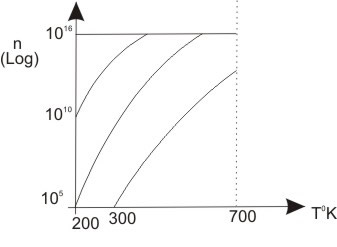Extrinsic Doping :
Imperities could be incorporated into the crystal which could either contribute extre electrons or could accept electrons.In the former,afer the contribution of the electron/s the impurity itself becomes positively charged(as it was neutral to start with)and into concentration is called ND+.In the latter case the impurity after accepting electron/s becomes negatively charged and its concentration is called NA -
Assuming uniform doping under equilibrium
 , Donors produce +ve ions, Acceptors produce -ve ions. , Donors produce +ve ions, Acceptors produce -ve ions.
if 
 , this is the charge neutrality relation. , this is the charge neutrality relation.

|
Fig.6.6 |
Relationship for  and and 
Now let N D = no. of donor atoms
and  = no. of donor atoms ionized = no. of donor atoms ionized
 is the ratio of no. of empty states to total no. of states in donor energy is the ratio of no. of empty states to total no. of states in donor energy
 g D = 2(standard value) g D = 2(standard value)
Similarly,  g A = 2(standard value) g A = 2(standard value)
In the above expressions, g D and g A are the degeneracy factors
From charge neutrality condition.

We have

 solving this equation given N V , N c , N A , E c , E v , T, E D , E A solving this equation given N V , N c , N A , E c , E v , T, E D , E A  we can find E F etc we can find E F etc
Free-out/Extrinsic T
Suppose N D > > N A and N D > > n:
electron concentration > > hole concentration. Also  . .

where  (a computable constant at a given T) (a computable constant at a given T)
Therefore, 
Solving this quadratic equation,
 , (+ve root chosen as , (+ve root chosen as  ) )
or, 
Similar result can be obtained for acceptor doped material.
 is typically much grater than N D is typically much grater than N D




 , p doped Si, T = 300 k , p doped Si, T = 300 k
n = 0.9996  , So 99.96% of P atoms are ionized at room temperature , So 99.96% of P atoms are ionized at room temperature
At T = 77 K i.e Liquid N 2 temperature, 
Special case of High Temperature
When a semiconductor is kept at a high temperature, most dopants area ionized
But we know that 
Therefore,
and
 donor doped donor doped 
 acceptor doped acceptor doped

|